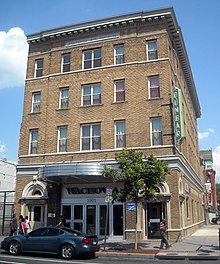Isaiah T. Hatton

Southern Aid Society building and Dunbar Theater (Southern Aid Society-Dunbar Theater Building)
Isaiah T. Hatton (1883–1921) was an architect in the United States known for his designs of buildings for his fellow African Americans.[1][2] Several are listed on the National Register of Historic Places.
Hatton was the only son of Isaiah and Mary Susan Hatton and was born on March 1, 1883, in Hagerstown, Maryland. His family moved to Washington D.C. when he was seven.[3] He married Bertha B. Sayles.[3] They did not have children.[3] Several buildings he designed are listed on the National Register of Historic Places (NRHP).[4]
Works[]

Whitelaw Apartment House (Whitelaw Hotel) in a photograph taken as part of the Historic American Buildings Survey
Selected works include:
- Third Baptist Church (1893), 1546 5th St., NW, Washington, D.C. (designed with fellow African American architect Calvin Brent), NRHP-listed[4]
- Thomas J. Calloway House (1910), 9949 Elm Street, Lanham, Maryland, for Thomas Junius Calloway, an African American developer of the Lincoln community in Lanham, Maryland in Prince Georges County, Maryland. NRHP-listed[4]
- His own residence at 5502 Center Ave (1911)[3] in Lincoln
- Industrial Bank building (1915) for at 12th and U streets NW[3] The bank's original location was in the Laborers' Building and Loan Association building designed by architect William Sidney Pittman. Although the bank closed in the 1930s, a Howard University graduate reopened it.[5][6]
- Isaiah T. Hatton House in the Buena Vista section of Prince George's County where he moved in 1918.[3]
- Whitelaw Hotel (1919), 1839 13th St. NW, Washington, D.C.[7] NRHP-listed[4] Also known as the Whitelaw Apartment House
- Southern Aid Society building (Southern Aid Society-Dunbar Theater Building), (1921) 1901–1903 Seventh St. NW, Washington, D.C., NRHP-listed[4]
- Daniel P. Seaton House[3] in Lincoln for the Dr. And A.M.E. minister who wrote a book advocating Christian Zionism
References[]
- ^ Wilson, Dreck Spurlock (1 March 2004). African American Architects: A Biographical Dictionary, 1865–1945. Routledge. ISBN 1135956286 – via Google Books.
- ^ "The Golden Age of Black Architects". 23 February 2000 – via www.washingtonpost.com.
- ^ a b c d e f g Dreck Spurlock Wilson (1 March 2004). African American Architects: A Biographical Dictionary, 1865–1945. Routledge. pp. 460–. ISBN 978-1-135-95628-8.
- ^ a b c d e "National Register Information System". National Register of Historic Places. National Park Service. November 2, 2013.
- ^ "Industrial Bank of Washington, African American Heritage Trail - www.culturaltourism.org". www.culturaltourismdc.org.
- ^ U Street Historic District brochure pages 14 and 15
- ^ "Whitelaw Hotel – The Whitelaw is an apartment hotel which long served as a unique place of meeting and public accommodation for prominent African American educators, entertainers, and other notable public figures during the era of segregation. – DC Historic Sites". DC Historic Sites.
Categories:
- 1883 births
- 1921 deaths
- 20th-century American architects
- African-American architects
- People from Hagerstown, Maryland
- Architects from Maryland
- Architects from Washington, D.C.
- 20th-century African-American artists